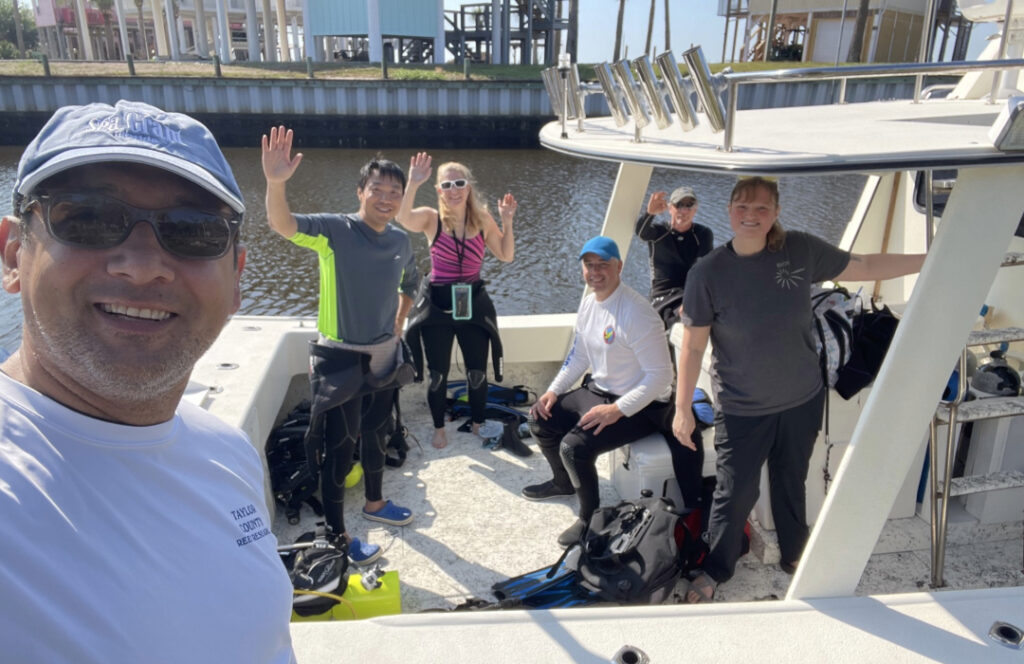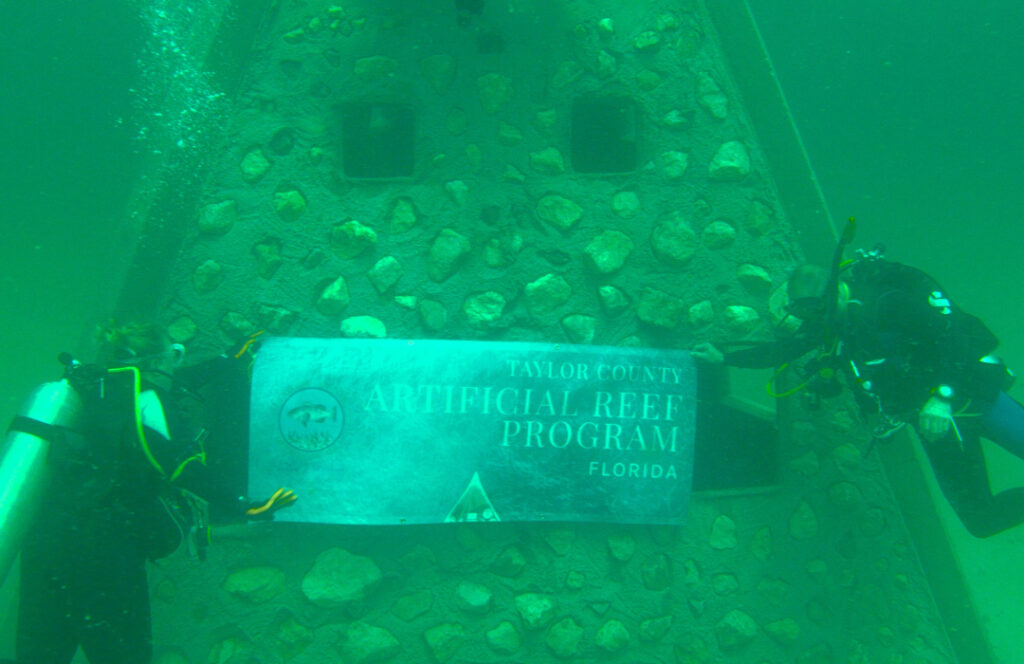Florida Sea Grant’s Artificial Reef Legacy is a 3-part series that explores the rich history of artificial reefs in Florida and highlights Florida Sea Grant’s longstanding support through science, monitoring, outreach, and education. In this installment, Taylor County FSG UF/IFAS Extension Agent, Victor Blanco, shares the human connections to artificial reefs, including Florida Sea Grant’s citizen science artificial reef monitoring program.
An underwater museum might sound far-fetched, but artificial reefs are relics from the past that symbolize both natural and human history. They act as artifacts, incorporating materials once used in buildings and infrastructure; they serve as historical markers, indicating dynamic marine conditions; and they commemorate individuals who have made lasting contributions in communities where reefs are placed.
Off the coast of Flagler County, 109 reef balls constructed by high school students from Mandarin High School in Jacksonville, were deployed into the sea, creating valuable marine habitat and recreational opportunities for local fishers and divers. The reef was named in honor of Joe Halusky, a longtime Florida Sea Grant Extension Program educator who played a vital role in the county’s marine efforts. Halusky’s early work in reef monitoring helped shape the protocols now used by the Florida Fish and Wildlife Conservation Commission (FWC), which requires monitoring as part of its artificial reef funding guidelines.
Monitoring efforts began with Joe Hulusky, Florida Sea Grant Extension Program educator, whose work laid the foundation in developing monitoring protocols for the Florida Fish and Wildlife Conservation Commission (FWC), which now requires monitoring as part of their funding guidelines.

Blanco with artificial reef monitoring divers. Image by Victor Blanco, Florida Sea Grant UF/IFAS Extension.
“Many of the methodologies used by local groups today were influenced by the work of Hulusky, who trained volunteer divers and worked closely with scientists involved in the scientific diver program. This initiative is considered one of the early examples of citizen science in the field,” says Dr. Lindberg.
The torch has now been passed to Florida Sea Grant Taylor County Extension Agent Victor Blanco, who leads monitoring programs in collaboration with the Florida Fish and Wildlife Conservation Commission (FWC) and leads the bidding committee with Taylor county members to assess contractor bids and reef options suitable for the county needs. Blanco oversees inspections, logistics, and material deployment, including pre-deployment surveys and post-deployment checks. He reports to the Florida Fish and Wildlife Conservation and county commissioners.
Blanco has played a key role in helping Taylor County establish a permanent, volunteer-based monitoring system for two artificial reef deployments that make up the 847-acre Buckeye Reef. The Buckeye Reef Program benefits from citizen science training, which formalizes the monitoring and enhancement of artificial reef habitat off Taylor County. Blanco has also introduced a new component to the monitoring and artificial reef initiative, with a focus on recreation.
“When I started the program in 2018, the goal was to build a community of divers —where they count fish, assess reef materials, and report data. Through the Citizen Science Program, we’ve enabled divers to visit these reef sites & see for themselves how rewarding it is to dive there,” says Blanco.
Through the Citizen Science Program, we’ve enabled divers to visit these reef sites & see for themselves how rewarding it is to dive there.
Victor Blanco

Volunteer divers at an artificial reef site in Taylor County. Image by Victor Blanco Florida Sea Grant UF/IFAS.
During these dives, volunteers receive training, which has enhanced the experience by deepening their understanding of the habitats they are exploring.
“One of my divers, Ruth, has been with us since 2019. I’ve seen her improve her fish identification skills over time, and now I feel confident that she can do fish counts on her own and report back to me. I trust her data. Every year, she returns and stays engaged,” Blanco adds.
The success of a reef is determined by different materials and configurations of the reef patch that sustain longterm and attract game fish. Divers collect information all the fish seen, and at the end, divers conduct a data analysis to focus on sportfish, which is then reported back to the community, via infographics and communication material produced by Blanco.
With Blanco’s continued support, FSG provided essential monitoring in 2021 for eight new permitted areas in the Buckeye Reef, enhancing the 800-acre fishing habitat—about the same size as Central Park in New York City!
The creation of artificial reefs is not just a scientific endeavor—it’s a community effort. Many reefs in Florida are named after local figures, events, or organizations that played a role in their creation. For example, the Dasher Reef is a memorial reef built from a sunken boat replica to honor a local angler who passed away. The Hulusky Reef in Northeast Florida commemorates Joe Hulusky’s work in the area’s marine extension. The Buckeye Reef is named after the Georgia Pacific’s Buckeye Mill- in Taylor County, which donated scrap metal to help create the reef.
“A group of local anglers, many of whom worked at the mill, helped gather large pieces of scrap metal when the mill was being rebuilt,” says Blanco. “This material was then used to create a reef in Taylor County, and it’s become a meaningful part of the local community.”
These reefs reflect the strong connections between people and the marine environment, and embody the concept of upcycling materials. The creativity and innovation involved in repurposing materials for new functions is an art in itself, preserve marine habitats for species and safeguard the history of local communities.
Read more about the diving and monitoring experience from our every own citizen scientist, Ruth McIlhenny. Dive into Part 3 of this series to learn more about Florida Sea Grant’s artificial reef deployment and outreach efforts.